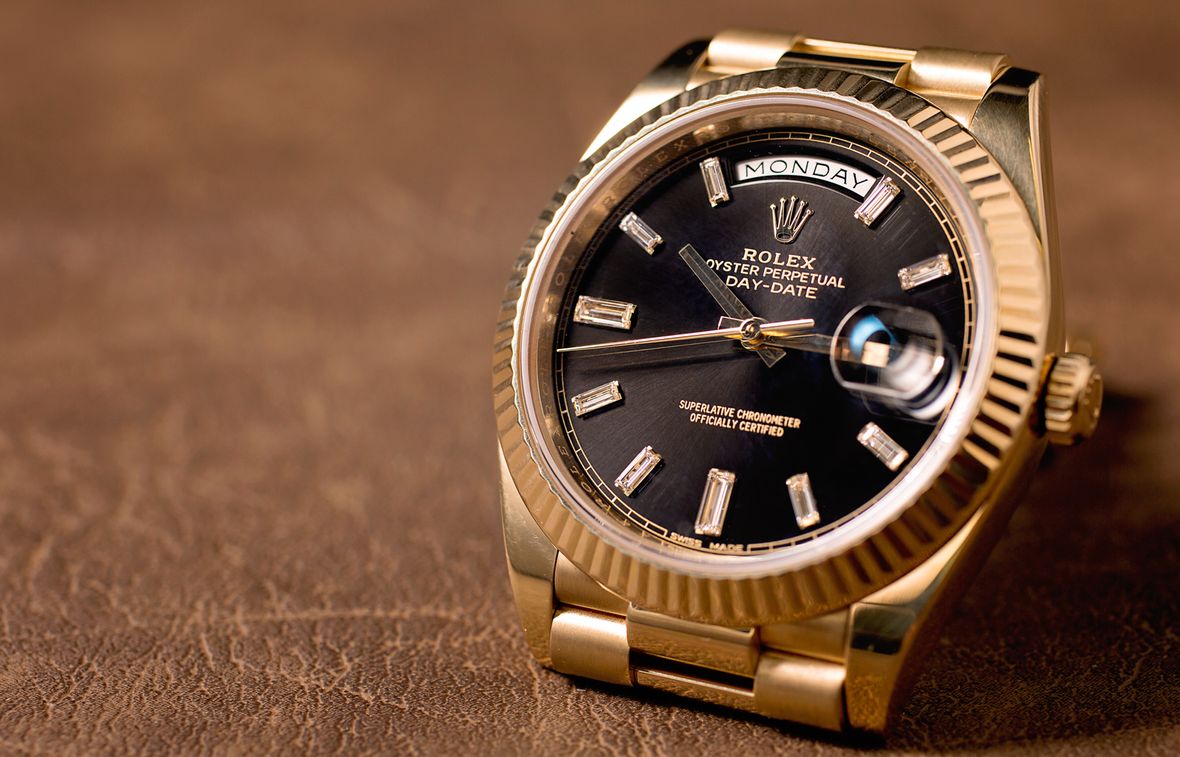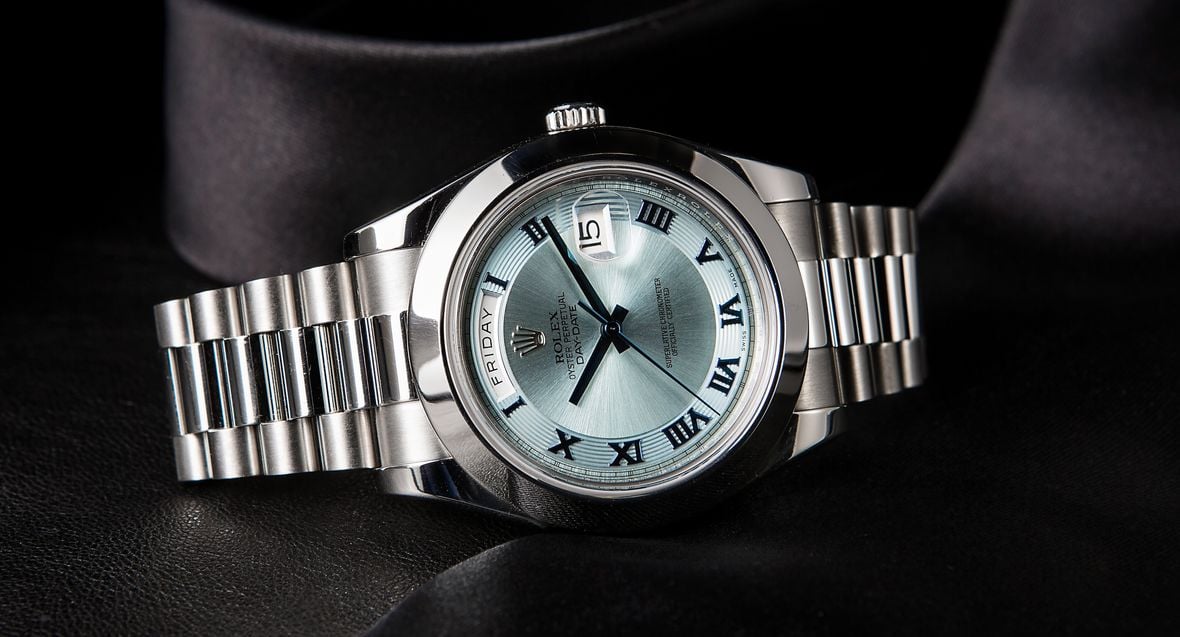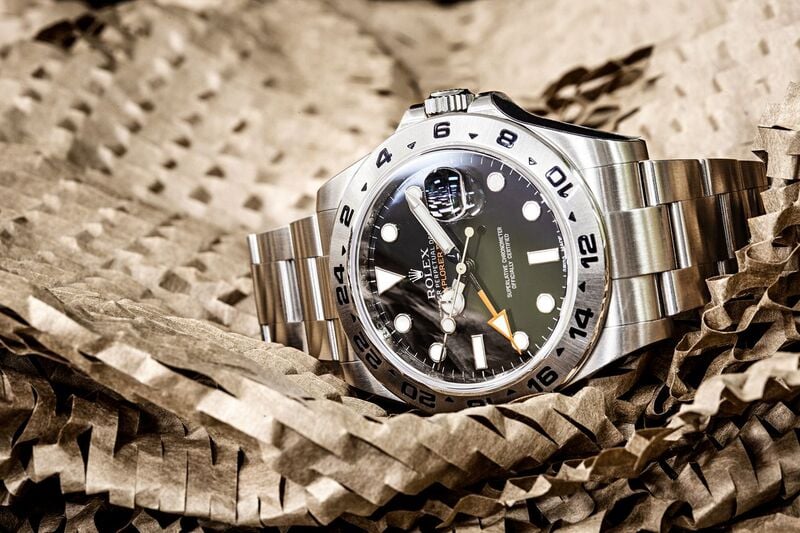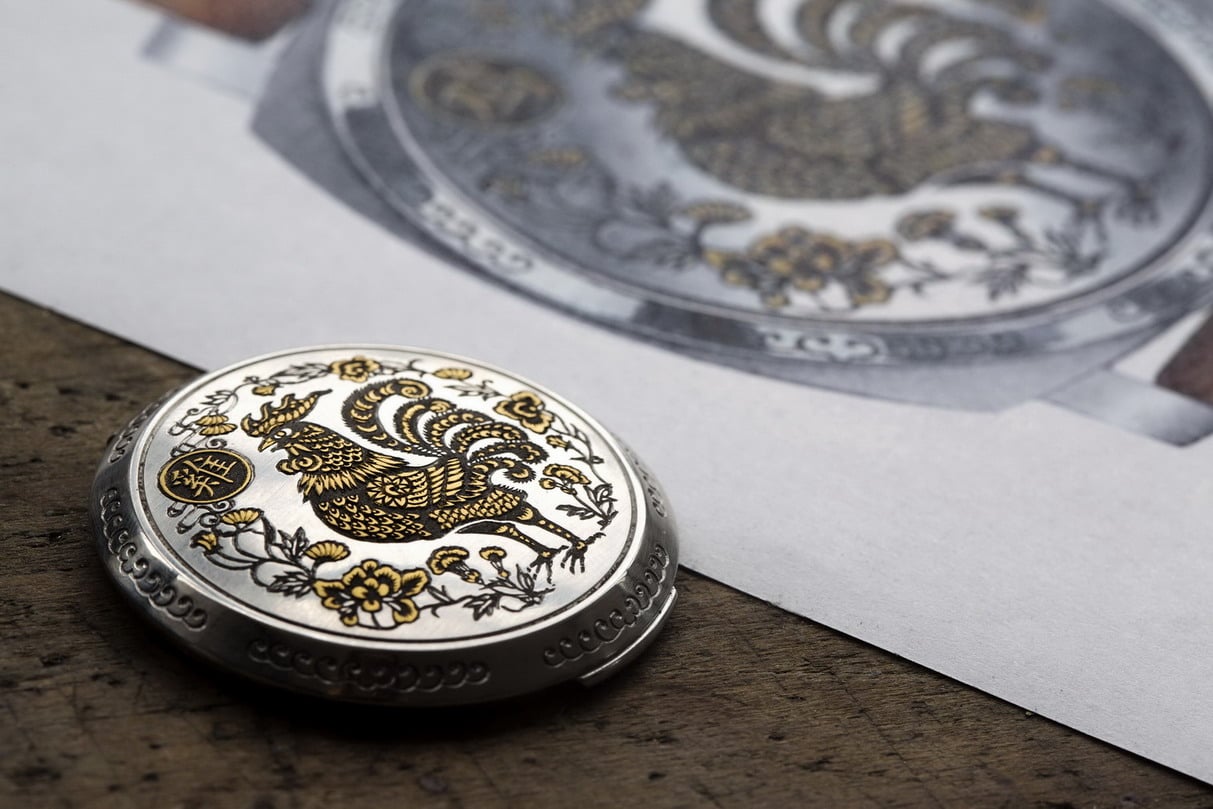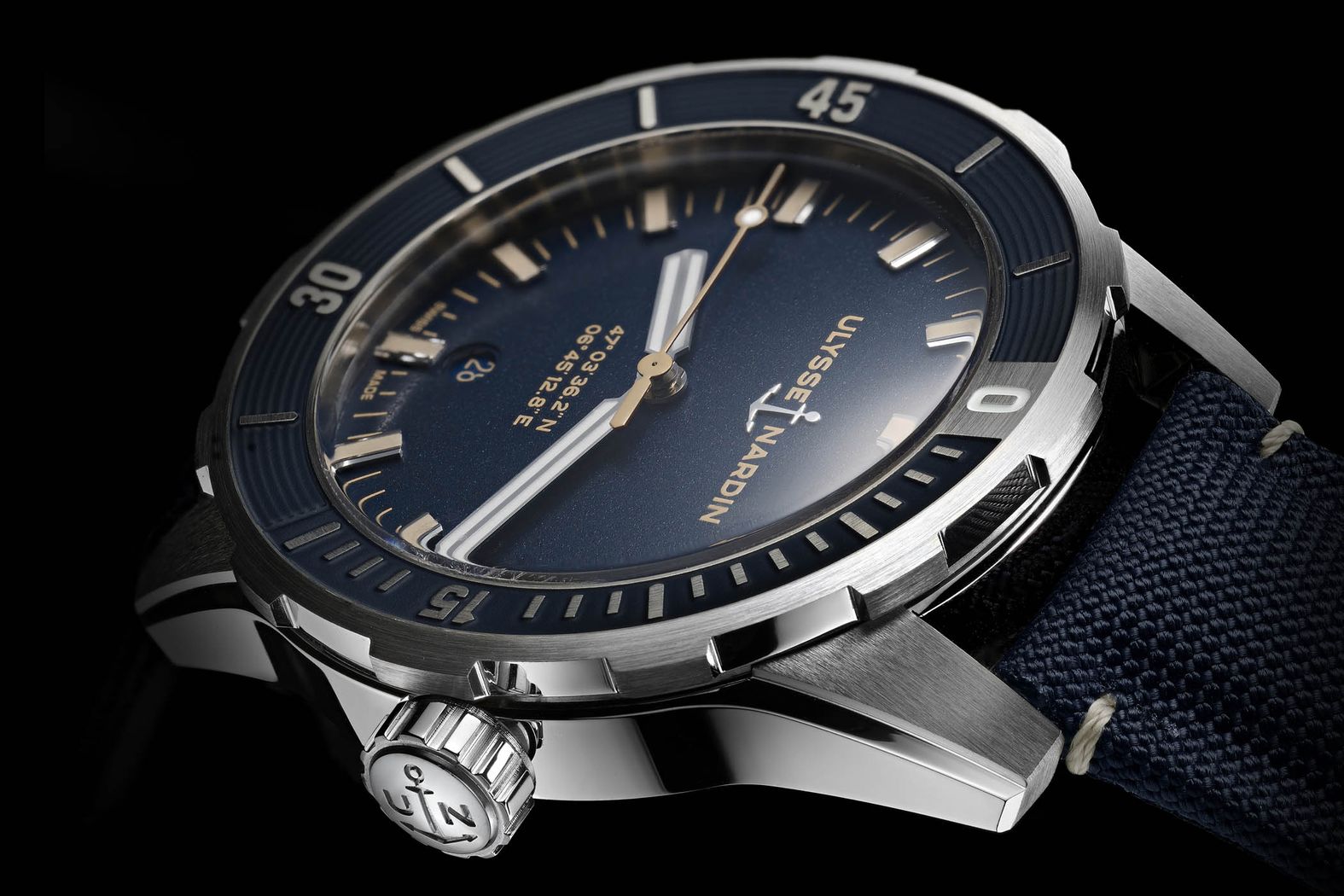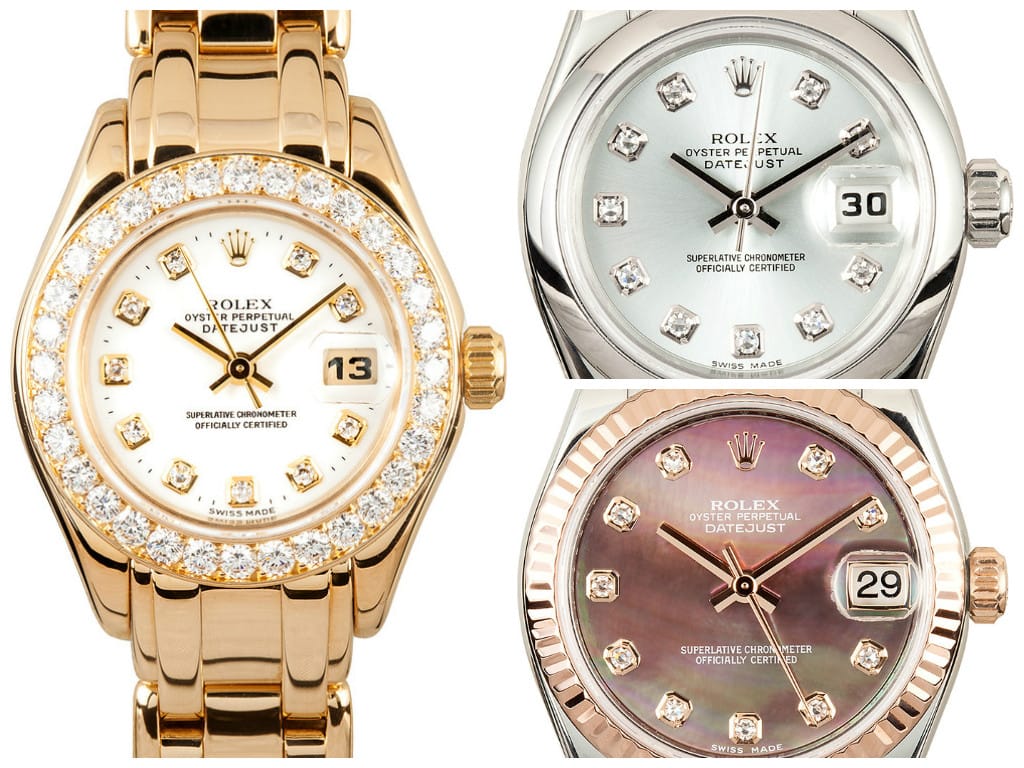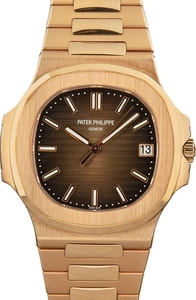Introduced in 1956, the Rolex Day-Date was the world’s first wristwatch to feature windows on the dial to display both the date of the month and the day of the week written out in full. Since then, the Day-Date, better known as the President watch, has grown to become Rolex’s ultimate symbol of prestige – a watch that denotes success and affluence.
For over fifty years, the Rolex President was exclusively available with a 36mm case. While there have been 39mm versions of the Day-Date, these were fitted with Pearlmaster bracelets and called Masterpiece Day-Date watches. Therefore, they are not considered true Rolex Presidential watches. 36mm was the classic size for the Day-Date since the very beginning but for some, it was too small for a men’s watch – even for a dress timepiece.
Therefore, in 2008, the Swiss watchmaker unveiled a noticeably larger Rolex President model fitted with a 41mm case named the Rolex Day-Date II. Then, seven short years later, Rolex replaced the Day-Date II with the slightly smaller Day-Date 40 model. Given their similar dimensions and styles, there can be some confusion as to how these two larger Day-Date watches differ from each other. So, let’s explore the differences and similarities between the Day-Date II and the Day-Date 40 to determine which Rolex President is the right fit for you.
Rolex Day-Date II vs. Rolex Day-Date 40
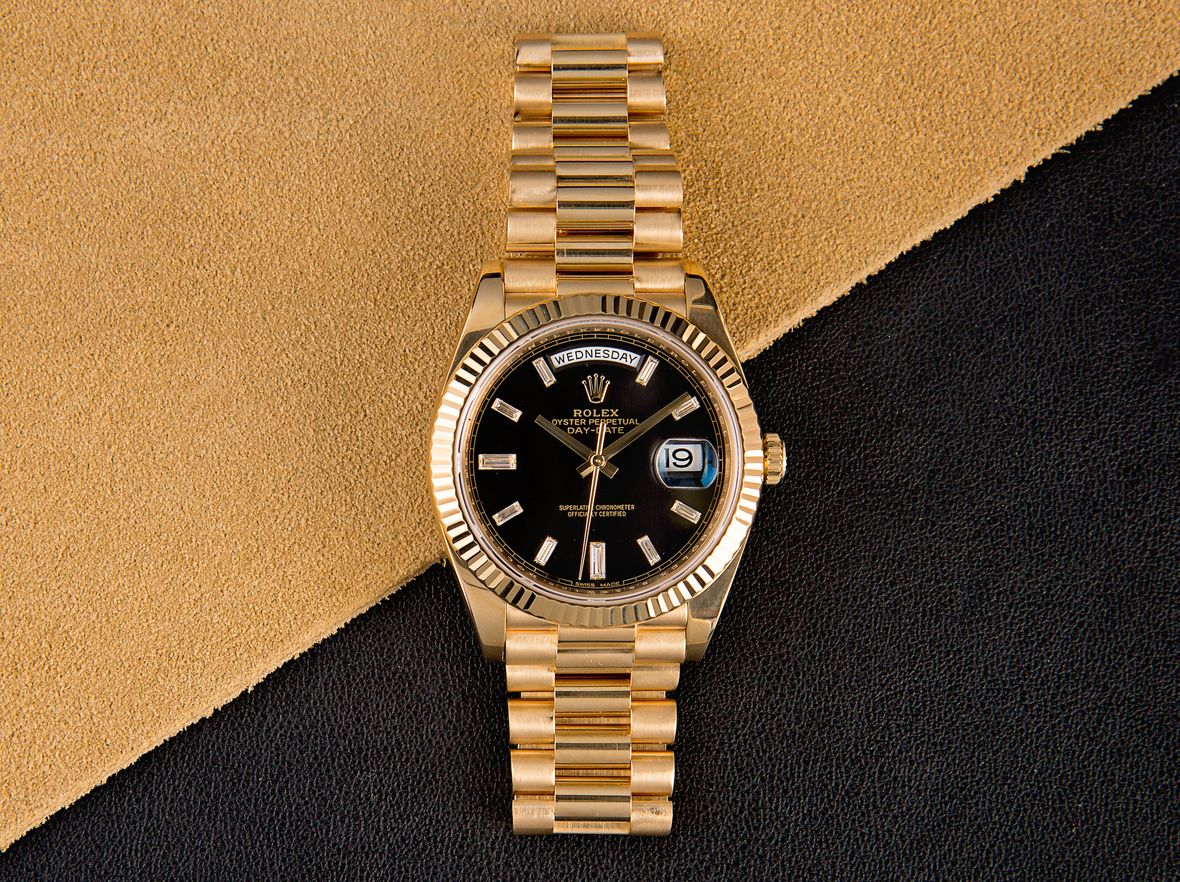
Rolex Day-Date II
Production Period: 2008 – 2015
Case size: 41mm
Materials: Yellow gold, white gold, Everose gold, or platinum
Bezel: Gold fluted, smooth platinum, or diamond-set
Bracelet: President
Water-Resistance: 100 meters / 330 feet
Movement: Caliber 3156
Rolex Day-Date 40
Production Period: 2015 – Present
Case size: 40mm
Materials: Yellow gold, white gold, Everose gold, or platinum
Bezel: Gold fluted, smooth platinum, or diamond-set
Bracelet: President
Water-Resistance: 100 meters / 330 feet
Movement: Caliber 3255
Click here for our Ultimate Buying Guide on the Rolex Day-Date.
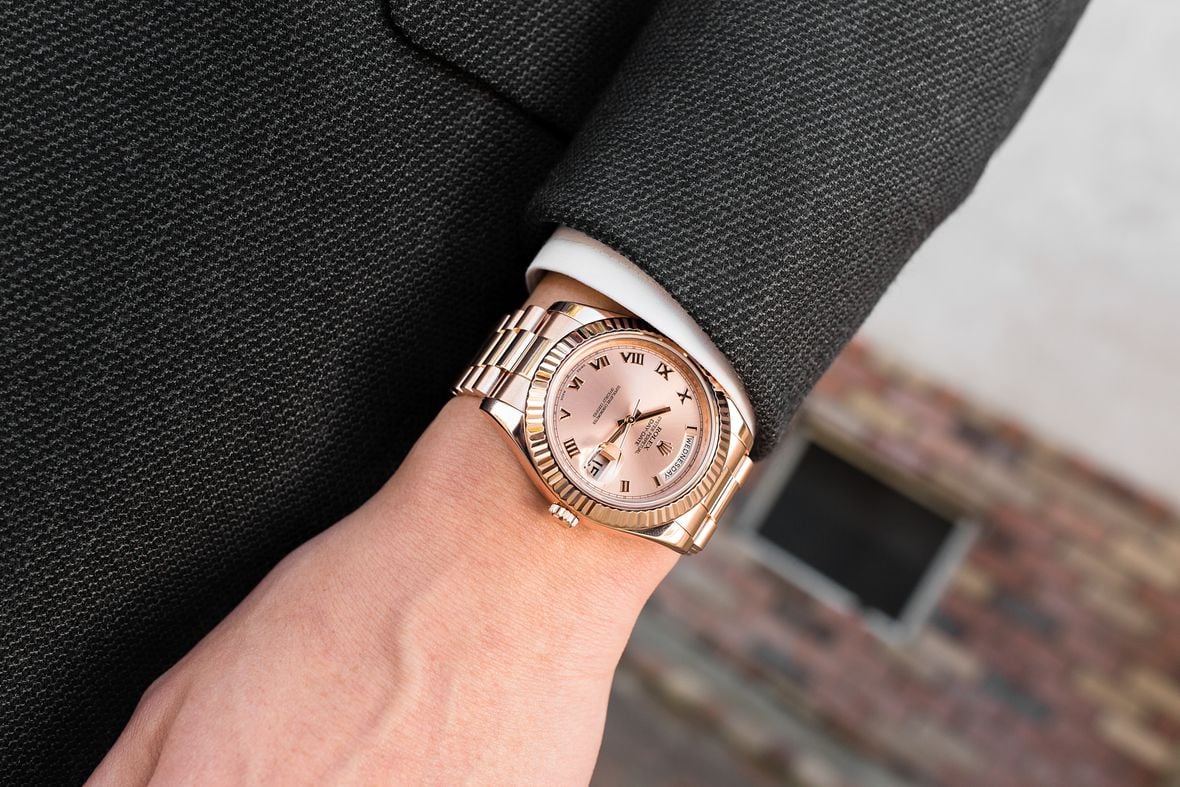
Size Differences: Day-Date II Vs Day-Date 40
The Oyster case of the Rolex Day-Date II measures 41mm, while (as its name suggests) the Day-Date 40 measures 40mm. Although on the outset the 1mm difference seems trivial, wearing the watch is a different story. Due to its thicker lugs, chunkier build, and wider bezel, the Rolex Day-Date II wears larger and offers a bolder wrist presence than the 1mm variance suggests.
Conversely, not only did Rolex trim 1mm from the case size of the Day-Date 40, but its overall style is more elegant thanks to a thinner profile, thinner bezel, and slimmer lugs. It may be hard to tell with a quick glance but if you hold the two models side-by-side, the differences become quite apparent.
In short, the size variations and silhouette redesign mean that the Day-Date II is regarded as the slightly sportier choice, while the Day-Date 40 is more aligned with the classic 36mm Day-Date style but in a larger format.
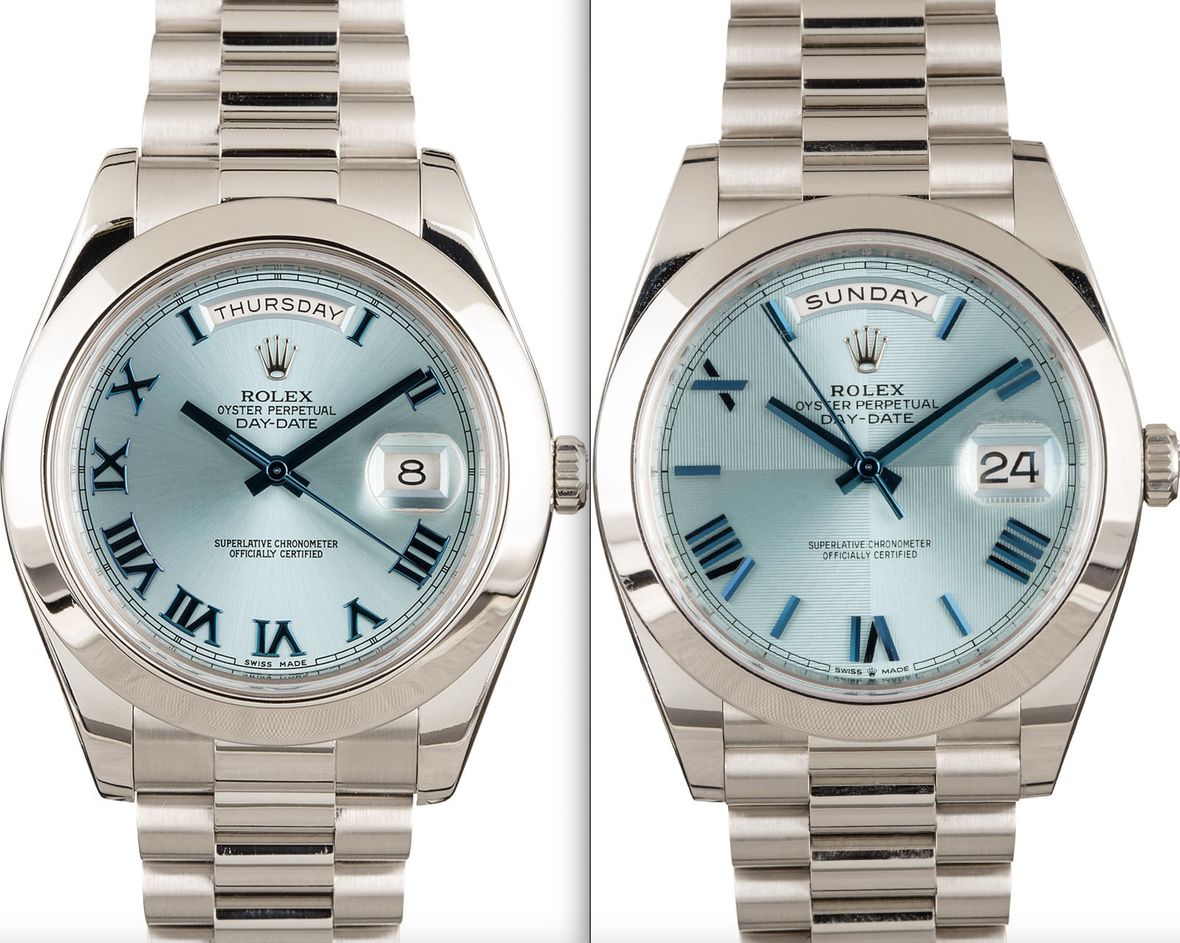
Material, Bezel, and Dial Variations: Day-Date II Vs Day-Date 40
One of the defining characteristics of all Rolex Day-Date watches, regardless of size or era, is their precious metal construction. Unlike its other models that offer steel or two-tone steel/gold variations, Rolex has only ever made the Day-Date in solid 18k gold or platinum. Nothing but the best for the Presidential watch and of course, this choice of material makes the Day-Date one of the priciest Rolex watches to own.
As always, both the Rolex Day-Date II and the Day-Date 40 collections offer iterations in yellow gold, white gold, Everose gold (Rolex’s proprietary rose gold alloy), and platinum. The gold variations come fitted with the classic fluted bezel while the platinum versions sport smooth bezels. Naturally, certain Rolex Day-Date II and Day-Date 40 watches also have the option of factory diamond-set bezels, including both round-cut and baguette-cut.
In true Rolex fashion, there are plenty of dial styles to choose from within both the Day-Date II and Day-Date 40, from various hour marker styles like Arabic numerals, Roman numerals, and diamonds to numerous colors like champagne, black, and silver. As is tradition with platinum Rolex watches, the platinum Day-Date 40 and Day-Date II models can also come with ice-blue dials. Furthermore, when Rolex introduced the Day-Date 40 in 2015, the company debuted a new laser etching process to create dial patterns including stripes, crisscross, and quadrant motifs.
Following in the footsteps of the classic Day-Date 36, the larger Day-Date watches feature a day window arching above 12 o’clock, which is available in 26 different languages. Also, the date window at 3 o’clock is magnified by a Cyclops lens protruding from the surface of the sapphire crystal above it.
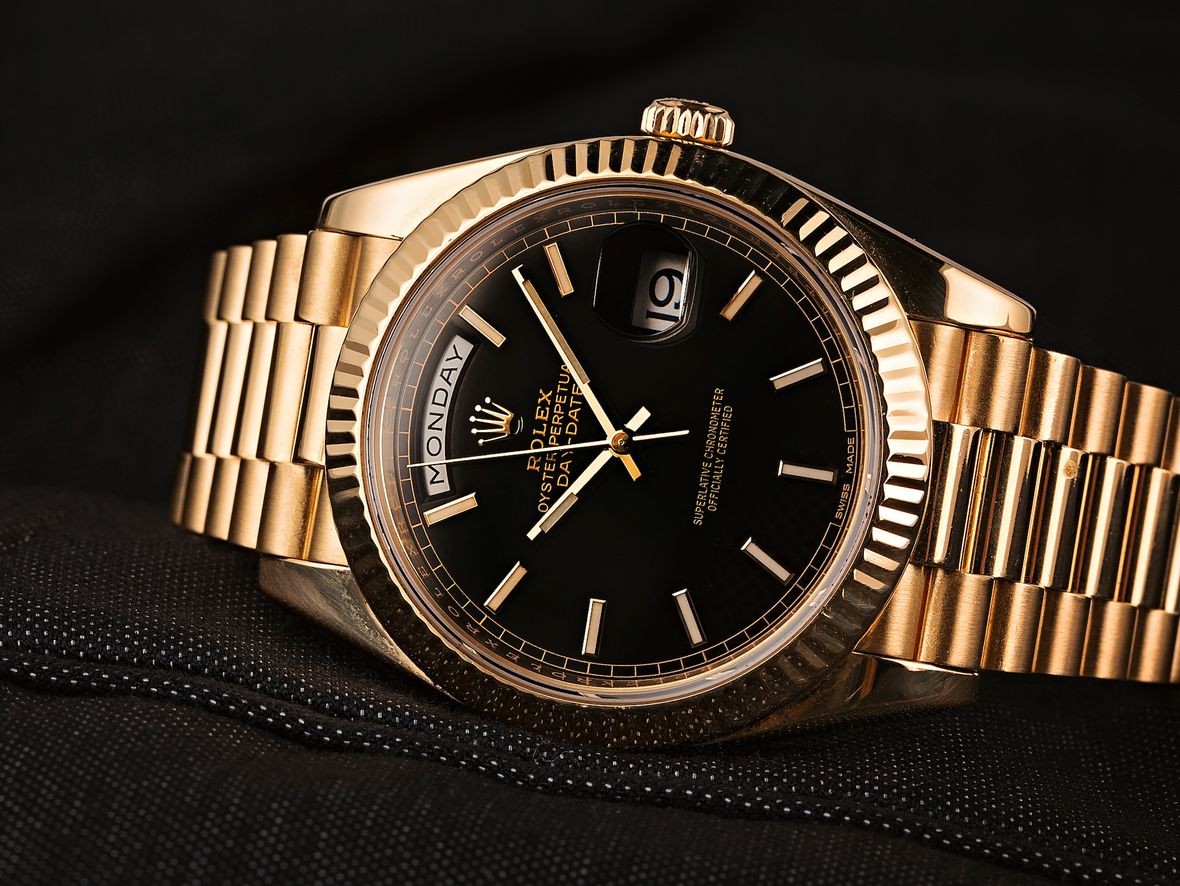
Day-Date II and Day-Date 40 References
One way to distinguish between the Rolex Day-Date II and the Day-Date 40 is to look at the reference numbers. The Day-Date II watches come with 218xxx reference numbers while the Day-Date 40 watches come with 228xxx reference numbers, where the last three digits denote the material and bezel type.
Rolex Day-Date II
Ref. 218238 – Yellow Gold, Fluted Bezel
Ref. 218348 – Yellow Gold, Diamond Bezel
Ref. 218239 – White Gold, Fluted Bezel
Ref. 218349 – White Gold, Diamond Bezel
Ref. 218235 – Everose Gold, Fluted Bezel
Ref. 218206 – Platinum, Smooth Bezel
Rolex Day-Date 40
Ref. 228238 – Yellow Gold, Fluted Bezel
Ref. 228348RBR – Yellow Gold, Diamond Bezel
Ref. 228398TBR – Yellow Gold, Baguette Diamond Bezel
Ref. 228239 – White Gold, Fluted Bezel
Ref. 228349RBR – White Gold, Diamond Bezel
Ref. 228235 – Everose Gold, Fluted Bezel
Ref. 228345RBR – Everose Gold, Diamond Bezel
Ref. 228206 – Platinum, Smooth Bezel
Ref. 228396TBR – Platinum, Baguette Diamond Bezel
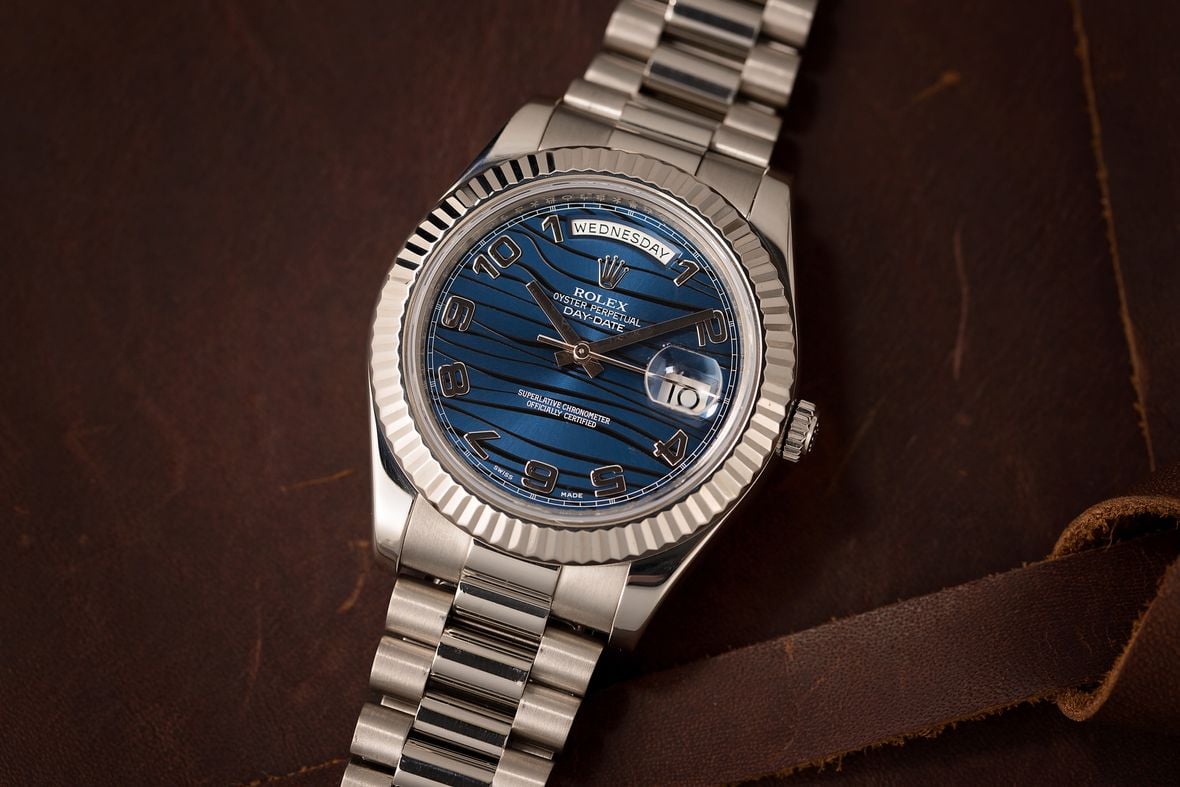
Bracelet Modifications: Day-Date II Vs Day-Date 40
Characterized by a three-piece arrangement of semi-circular links, the Rolex President bracelet was made specifically for the Day-Date watch’s launch in 1956. Although select Day-Date models have also been available with other bracelet options over the decades, such as leather straps, Oyster bracelets, and even Pearlmaster bracelets, many collectors believe that a Rolex President looks best on the iconic President bracelet.
Both the Rolex Day-Date II and Rolex Day-Date 40 models are exclusively furnished with President bracelets fitted with the concealed folding Crownclasp. Platinum versions of the Day-Date II include ceramic inserts in between the links to prevent bracelet stretching over time. On the other hand, all Rolex Day-Date 40 models have bracelet ceramic inserts in their bracelet links.
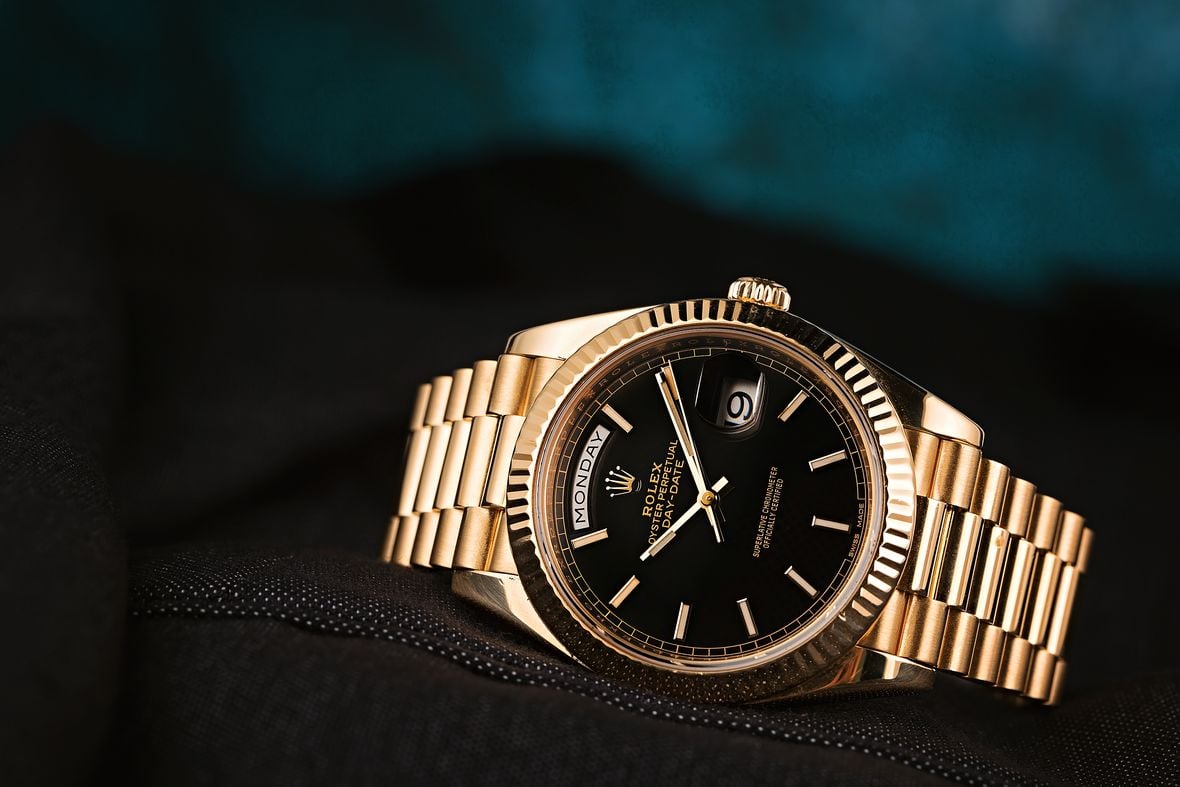
Caliber Change: Day-Date II Vs Day-Date 40
The biggest difference between the Day-Date II and the Day-Date 40 is one that isn’t seen on the outside – instead, it’s housed within the Oyster case. Powering the Day-Date II is the very reliable Cal. 3156 automatic movement with time, day, and date functions, as well as a power reserve of about 48 hours.
In 2015, Rolex debuted the new Caliber 3255 automatic movement inside the Day-Date 40. Boasting 14 patents and a power reserve of approximately 70 hours, Rolex has achieved improvements in precision, autonomy, shock-resistance, anti-magnetism, and overall reliability with its newest generation of in-house movements.
Both chronometer-rated Rolex calibers benefit from the following:
– COSC-certified
– Parachrom hairspring
– Paraflex shock absorbers
Moreover, both Rolex Day-Date models also include double-quickset functionality, which means that both the day and date indications can be adjusted independently from the time-telling hands.
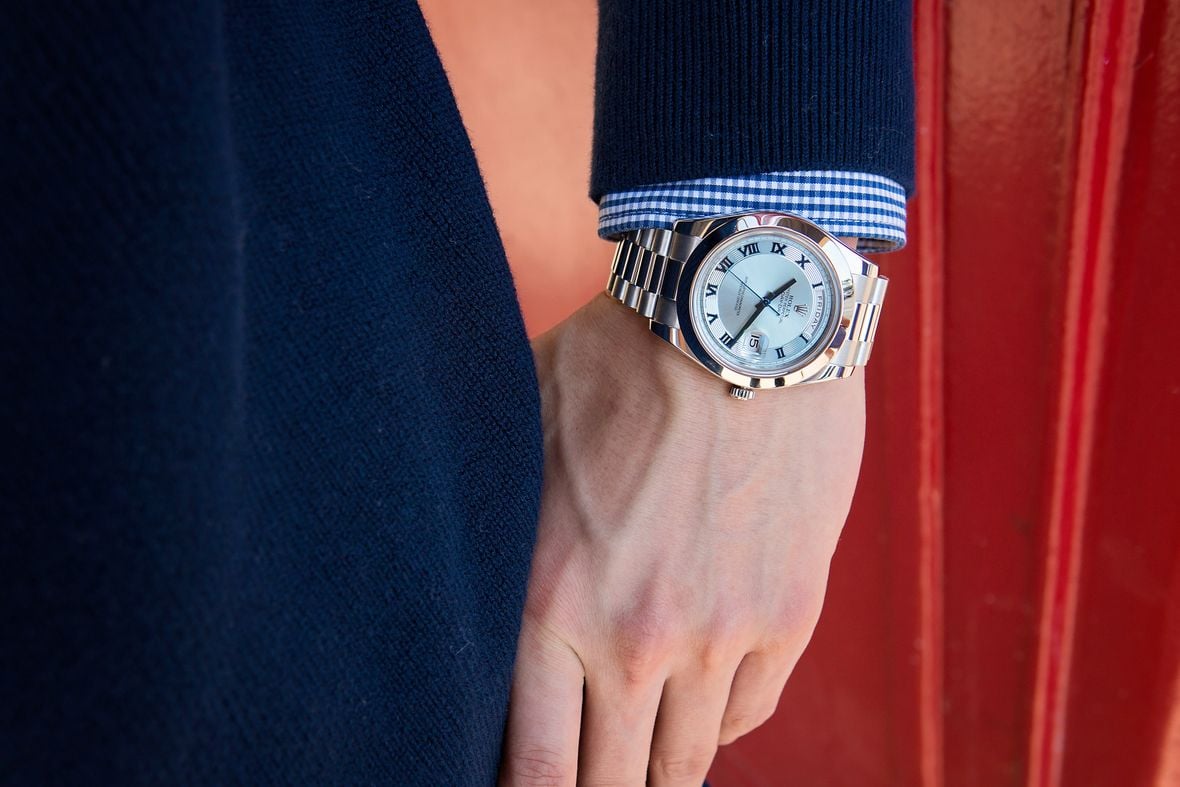
Buying the Discontinued Day-Date II vs. Current Day-Date 40
Given that the Rolex Day-Date II is no longer in production, the only place to source one is from the pre-owned market. Alternatively, the Rolex Day-Date 40 is a current-production model, and it can be purchased either at a retail level or from the secondary market.
The starting price for a brand-new Rolex Day-Date 40 at retail is $36,550 for the yellow gold ref. 228238. Prices quickly go up from there for diamond embellishments on the bezel or dial and for other material options – platinum, white gold, and Everose gold all cost more than traditional 18k yellow gold.
While not too long ago there used to be about a $10,000 difference between the Rolex Day-Date II and Day-Date 40, the value of the Day-Date II has increased quite dramatically where price points for both models are now quite similar on the secondary market, and both are currently trading hands for values above their original retail prices. For instance, pre-owned Rolex Day-Date II ref. 218238 and Day-Date 40 ref. 228238 watches start out at around the $40,000 mark.
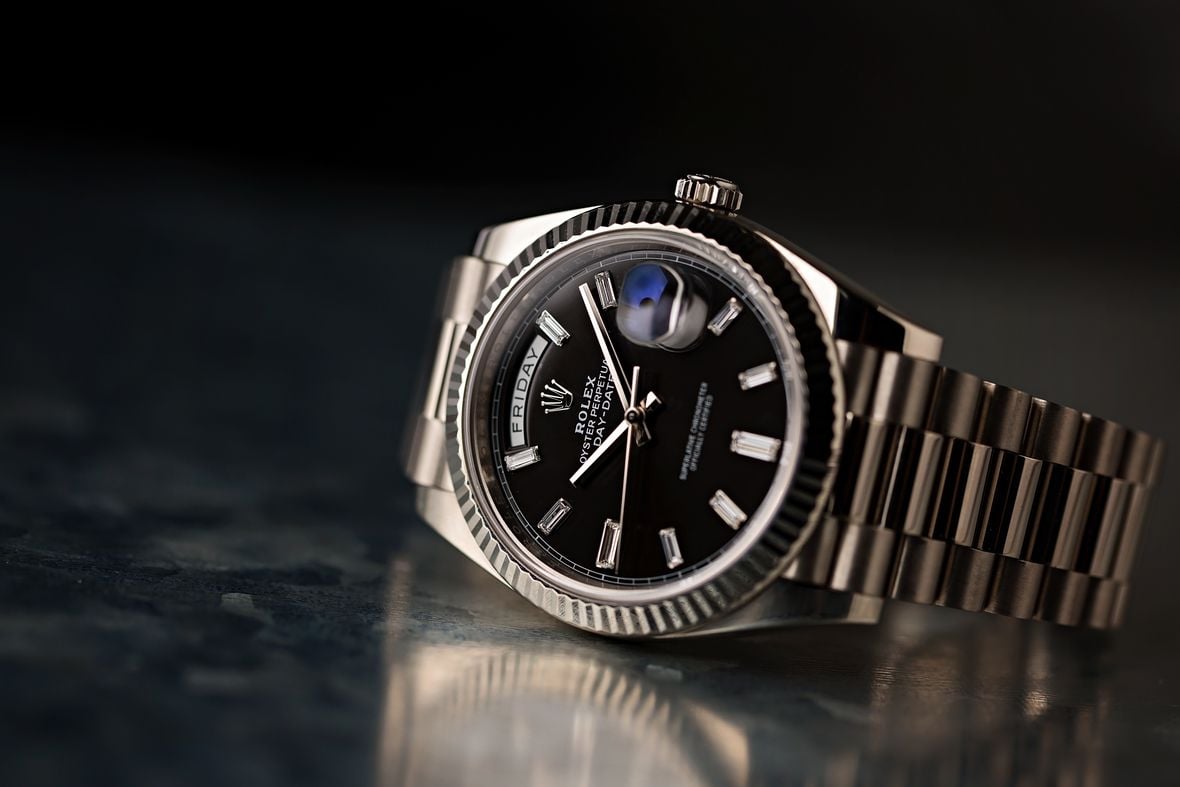
Which Rolex President Will It Be?
To sum up the similarities and differences between the Rolex Day-Date II and the Rolex Day-Date 40, here’s a quick table of their specifications.
| Model | Rolex Day-Date II | Rolex Day-Date 40 |
| Production Years | 2008 – 2015 | 2015 – Present |
| Case Size | 41mm | 40mm |
| Material Options | Yellow gold, white gold, Everose gold, platinum | Yellow gold, white gold, Everose gold, platinum |
| Bezel Options | Gold fluted, smooth platinum, diamond-set | Gold fluted, smooth platinum, diamond-set |
| Bracelet | President; platinum version with ceramic inserts | President; all versions with ceramic inserts |
| Movement | Caliber 3156 (48-hour power reserve) | Caliber 3255 (70-hour power reserve) |
| Water-Resistance | 100 meters / 330 feet | 100 meters / 330 feet |
Both models are spectacular larger versions of the quintessential Rolex status-symbol watch and both offer a timeless and classic design that has been in-style since it first made an appearance in 1956. Although there are a number of different characteristics separating these two Rolex models, choosing between the Day-Date II and the Day-Date 40 is a matter of deciding whether a bolder sporty version or a classic dressier version of the iconic Rolex President is right for you.
